
The Great Baltimore Fire raged in Baltimore, Maryland, United States from Sunday, February 7, to Monday, February 8, 1904. More than 1,500 buildings were completely leveled, and some 1,000 severely damaged, bringing property loss from the disaster to an estimated $100 million. 1,231 firefighters helped bring the blaze under control, both professional paid truck and engine companies from the Baltimore City Fire Department (B.C.F.D.) and volunteers from the surrounding counties and outlying towns of Maryland, as well as out-of-state units that arrived on the major railroads. It destroyed much of central Baltimore, including over 1,500 buildings covering an area of some 140 acres (57 ha).
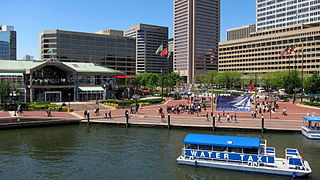
Harborplace is a shopping complex on the Inner Harbor in Baltimore, Maryland.

The Maryland Zoo — also known as The Maryland Zoo in Baltimore and formerly known as The Baltimore City Zoo or the Baltimore Zoo — is a 135-acre park located in historic Druid Hill Park in the northwestern area of the City of Baltimore, Maryland, (U.S.A.), with the postal address of 1876 Mansion House Drive. Druid Hill was opened in 1876 as the first major park purchase by the City under foreseeing Mayor Thomas Swann (1809-1883), and was later designed by famed nationally-known landscaper Frederick Law Olmsted (1822-1903), with additional work on various park buildings contributed by future Baltimore City Hall architect George A. Frederick (1842-1924), and Park Commissioner John H.B. Latrobe, who also was an accomplished lawyer, author, artist, amateur architect and civic leader. Olmsted had earlier won a contest for the design of plans for New York City's famed Central Park in mid-town Manhattan in 1858, a year after it opened, and worked on the massive public works project during its construction from 1858 to 1873. The Maryland Zoo is now currently home to over 2,000 animals, and is accredited by the Association of Zoos and Aquariums (AZA).
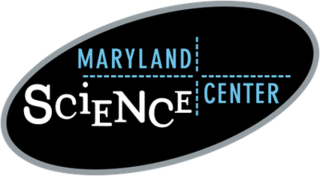
The Maryland Science Center, located in Baltimore's Inner Harbor, opened to the public in 1976. It includes three levels of exhibits, a planetarium, and an observatory. It was one of the original structures that drove the revitalization of the Baltimore Inner Harbor from its industrial roots to a thriving downtown destination. In 1987, an IMAX theater was added, but the museum continued to show its age as the end of the 20th century approached. In 2004, a large addition to the property was opened, and the modernized hands-on exhibits now include more than two dozen dinosaur skeletons. Subjects that the center displays include physical science, space, Earth science, the human body, and blue crabs that are native to the Chesapeake Bay.

The Museum of Discovery is located in downtown Little Rock, Arkansas. The museum is housed in a historic building in the River Market District on the Arkansas River. The Clinton Presidential Center is within walking distance.

The Baltimore Museum of Art (BMA) in Baltimore, Maryland, United States, is an art museum that was founded in 1914. The BMA's internationally renowned collection of 95,000 objects encompasses more than 1,000 works by Henri Matisse anchored by the Cone Collection of modern art, as well as one of the nation's finest holdings of prints, drawings, and photographs. The galleries currently showcase collections of art from Africa; works by established and emerging contemporary artists; European and American paintings, sculpture, and decorative arts; ancient Antioch mosaics; art from Asia, and textiles from around the world.

Downtown Las Vegas is the central business district and historic center of Las Vegas, Nevada. It is the original townsite and was the gambling district of Las Vegas prior to the Strip, and the area still incorporates downtown gaming. As the urban core of the Las Vegas Valley, it features a variety of hotel and business highrises, cultural centers, historical buildings and government institutions, as well as residential and retail developments. Downtown is located in the center of the Las Vegas Valley and just north of the Las Vegas Strip, centered on Fremont Street, the Fremont Street Experience and Fremont East. The city defines the area as bounded by I-15 on the west, Washington Avenue on the north, Maryland Parkway on the east and Sahara Avenue on the south.
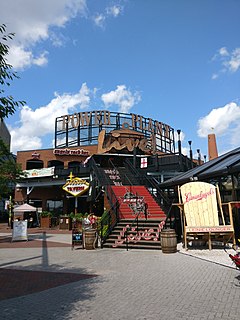
Power Plant Live! is a collection of bars, restaurants and other businesses in the Inner Harbor section of downtown Baltimore, Maryland. It was developed by The Cordish Companies and opened in phases during 2001, 2002, and 2003. The entertainment complex gets its name from the nearby "Power Plant" building, three blocks south on municipal Pier 4 on East Pratt Street facing the Inner Harbor, which was also later re-developed by Cordish.
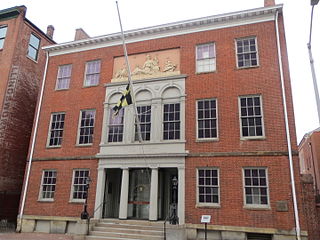
The Peale Museum, officially the Municipal Museum of the City of Baltimore, was a museum of paintings and natural history, located in Baltimore, Maryland, United States. It occupied the first building in the Western Hemisphere to be designed and built specifically as a museum. The museum was imagined by American artist and inventor Rembrandt Peale (1778–1860) and designed by architect Robert Cary Long, Sr. Much later, it functioned separately as Baltimore City's historical museum while the original structure was being rebuilt, restored, and renovated in 1930–1931, and then was merged with other historic sites, houses and museums in the early 1980s under the expansive efforts of a new executive director, with the name of the Baltimore City Life Museums and a broader mission in conjunction with the other historical locations/sites/structures in Baltimore.
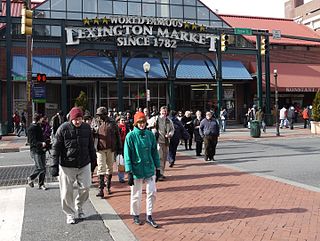
Lexington Market is a historic market in downtown Baltimore, Maryland, United States. The main market is housed in two large buildings on the north corners of the intersection of Paca and Lexington Streets. In the broader sense, Lexington Market encompasses both the main market and all of the shops on Lexington Street from Greene Street to Liberty Street.

The Duke Energy Children's Museum, formerly the Cinergy Children's Museum, is a museum in Cincinnati, Ohio, in the United States. It is one of the museums comprising the Cincinnati Museum Center at Union Terminal. Opened in 1998, the museum was moved from historic Longworth Hall near downtown Cincinnati location following the Ohio River Valley Flood of March 1997 that inundated it.
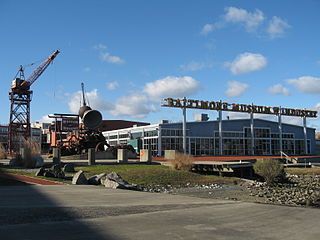
Baltimore Museum of Industry is a museum in Baltimore, Maryland, United States. Located in an old cannery, the museum has exhibits on various types of manufacturing and industry from the early 20th century. There are several hands-on sections with working equipment and other artifacts.
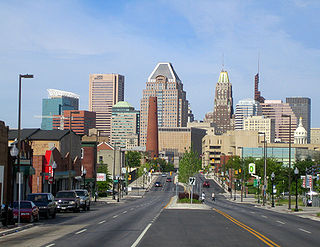
Downtown Baltimore is the central business district of the city of Baltimore traditionally bounded by Martin Luther King, Jr. Boulevard to the west, Franklin Street to the north, President Street to the east and the Inner Harbor area to the south.

The Rosewood Center was an institution for people with developmental disabilities located on Rosewood Lane in Owings Mills, Maryland.

Marbles Kids Museum is a nonprofit children's museum located in downtown Raleigh, North Carolina in the Moore Square Historic District.

Lombard Street is a major street in Baltimore. It forms a one-way pair of streets with Pratt Street that run west–east through downtown Baltimore. For most of their route, Pratt Street is one-way in an eastbound direction, and Lombard Street is one-way westbound. Both streets begin in west Baltimore at Frederick Avenue and end in Butcher's Hill at Patterson Park Avenue. Since 2005, these streets have been open to two-way traffic from Broadway until their end at Patterson Park; in addition, Lombard is also two-way from Fulton Avenue to Martin Luther King, Jr. Boulevard, near the University of Maryland at Baltimore campus.
St. Paul Street and Calvert Street are a one-way pair of streets in Downtown Baltimore and areas north. The streets, which are part of Maryland Route 2, are two of Baltimore's best-known streets in the downtown area.

Discovery Station, is a hands-on, family-friendly museum in downtown Hagerstown, Maryland, United States that opened to the public in 2005. The museum's focus is to create an environment that stimulates curiosity for discovery, exploration, and further investigation through exhibits and programs that focus on Science, Technology, Engineering, Art, and Math (STEAM) principles. The museum is a member of the Association of Science and Technology Centers (ASTC), the American Alliance of Museums (AAM), and the NASA Museum Alliance.
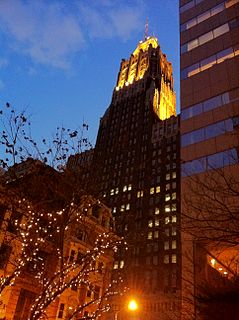
Charles Center is a large-scale urban redevelopment project in central Baltimore's downtown business district of the late 1950s and early 1960s. Beginning in 1954, a group called the "Committee for Downtown" promoted a master plan for arresting the commercial decline of central Baltimore. In 1955, the "Greater Baltimore Committee", headed by banker and developer James W. Rouse, joined the effort. A plan was developed by noted American urban planner and architect David A. Wallace, (1917−2004), strongly supported by Mayors Thomas L. J. D'Alesandro, Jr. (1947−1959) and Theodore R. McKeldin, and many in their administrations, which formed the basis of a $25 million bond issue voted on by the citizens of Baltimore City during the municipal elections in November 1958. The architects' view of the overall Charles Center Redevelopment Plan with the conceptions of possible buildings, lay-out and plan that was publicized to the voters that spring and summer before, only slightly resembles the actual buildings and designs that later were really constructed by the mid-1970s.
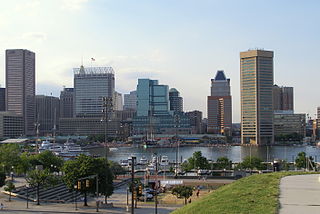
Baltimore is the most populous city in the U.S. state of Maryland, as well as the 30th most populous city in the United States, with a population of 585,708 in 2020. Baltimore was designated an independent city by the Constitution of Maryland in 1851, and today is the largest independent city in the United States. As of 2017, the population of the Baltimore metropolitan area was estimated to be around 2.8 million, making it the 21st largest metropolitan area in the country. Baltimore is located about 40 miles (64 km) northeast of Washington, D.C., making it a principal city in the Washington–Baltimore combined statistical area (CSA), the third-largest CSA in the nation, with a calculated 2018 population of 9,797,063.























